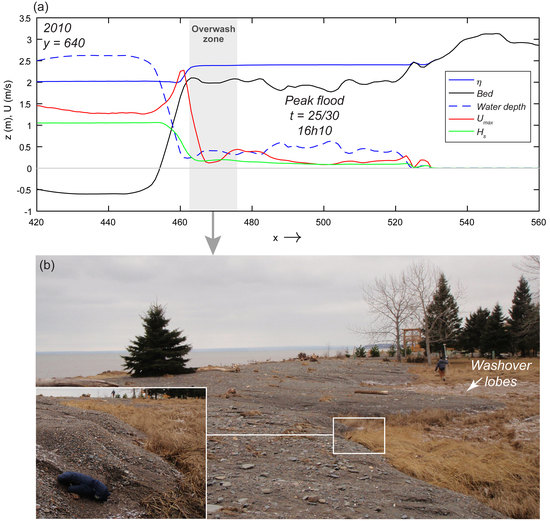Modelling Coastal Flood Propagation under Sea Level Rise: A Case Study in Maria, Eastern Canada
Abstract
:1. Introduction
2. Materials and Methods
2.1. Study Area and Flood Surveys
2.2. Topo-Bathymetric Data
2.3. Offshore Waves and Water Levels
2.4. Nearshore Waves and XBeach Validation
2.5. Actual and Future Design Storm Simulations
3. Results and Discussion
3.1. XBeach Validation
3.2. Understanding the Flood Propagation
3.3. Impacts of Sea Level Rise on Flood Hazard
4. Conclusions
Author Contributions
Funding
Acknowledgments
Conflicts of Interest
Abbreviations
| DEM | Digital Elevation Model |
| DF | Debris Factor |
| DTM | Digital Terrain Model |
| DSM | Digital Surface Model |
| EGSL | Estuary and Gulf of St. Lawrence |
| GCP | Ground Control Points |
| GIA | Glacio-Isostatic Adjustment |
| HAT | Highest Astronomical Tide |
| HR | Hazard Rating |
| IDF | Intensity-Duration-Frequency |
| IS | Inner lower foreshore sensor |
| LAT | Lowest Astronomical Tide |
| MTLS | Mobile Terrestrial LiDAR Survey |
| OS | Outer lower foreshore sensor |
| RTK-GPS | Real-Time Kinematic Global Navigation Satellite System |
| RP | Return Period |
| SWL | Still water level |
| TWL | Total Water Level |
Appendix A
Appendix A.1. Video-Derived Intertidal Topobathymetry
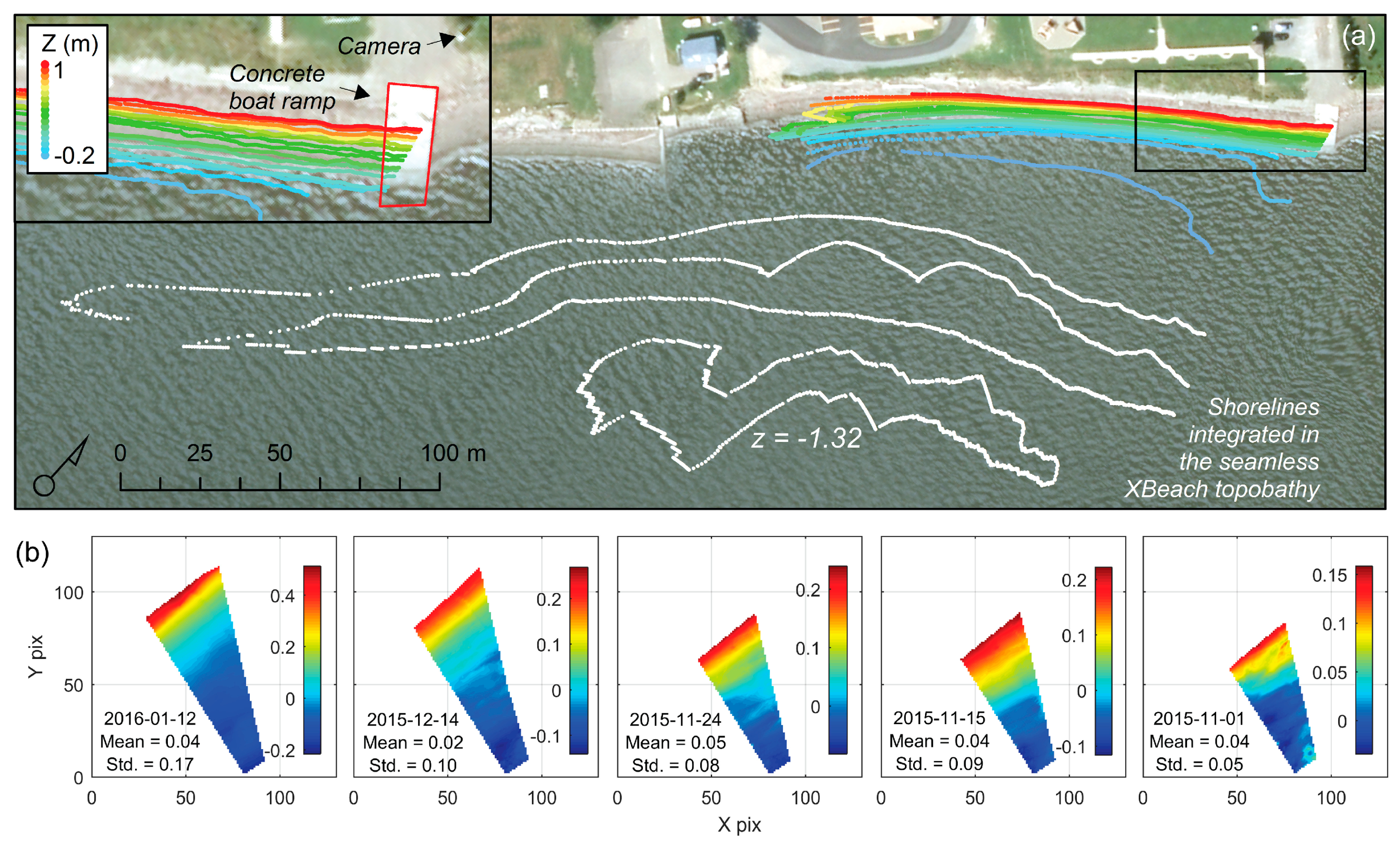
Appendix A.2. Description of the WW3 Hindcast
References
- Luijendijk, A.; Hagenaars, G.; Ranasinghe, R.; Baart, F.; Donchyts, G.; Aarninkhof, S. The State of the World’s Beaches. Sci. Rep. 2018, 1–11. [Google Scholar] [CrossRef] [PubMed]
- Muis, S.; Verlaan, M.; Nicholls, R.J.; Brown, S.; Hinkel, J.; Lincke, D.; Vafeidis, A.T.; Scussolini, P.; Winsemius, H.C.; Ward, P.J. A comparison of two global datasets of extreme sea levels and resulting flood exposure. Earth Future 2017, 5, 379–392. [Google Scholar] [CrossRef]
- Wahl, T.; Haigh, I.D.; Nicholls, R.J.; Arns, A.; Dangendorf, S.; Hinkel, J.; Slangen, A.B.A. Understanding extreme sea levels for broad-scale coastal impact and adaptation analysis. Nat. Commun. 2017, 8, 1–12. [Google Scholar] [CrossRef] [PubMed]
- Hinkel, J.; Lincke, D.; Vafeidis, A.T.; Perrette, M.; Nicholls, R.J.; Tol, R.S.J.; Marzeion, B.; Fettweis, X.; Ionescu, C.; Levermann, A. Coastal flood damage and adaptation costs under 21st century sea-level rise. Proc. Natl. Acad. Sci. USA 2014, 111, 3292–3297. [Google Scholar] [CrossRef] [PubMed]
- Koohzare, A.; Vaníček, P.; Santos, M. Pattern of recent vertical crustal movements in Canada. J. Geodyn. 2008, 45, 133–145. [Google Scholar] [CrossRef]
- Ruest, B.; Neumeier, U.; Dumont, D.; Bismuth, E.; Senneville, S.; Caveen, J. Recent wave climate and expected future changes in the seasonally ice-infested waters of the Gulf of St. Lawrence, Canada. Clim. Dyn. 2016, 46, 449–466. [Google Scholar] [CrossRef]
- Lerma, A.N.; Bulteau, T.; Elineau, S.; Paris, F.; Durand, P.; Anselme, B.; Pedreros, R. High-resolution marine flood modelling coupling overflow and overtopping processes: Framing the hazard based on historical and statistical approaches. Nat. Hazards Earth Syst. Sci. 2018, 18, 207–229. [Google Scholar] [CrossRef]
- Tomás, A.; Méndez, F.J.; Medina, R.; Jaime, F.F.; Higuera, P.; Lara, J.L.; Ortiz, M.D.; Álvarez de Eulate, M.F. A methodology to estimate wave-induced coastal flooding hazard maps in Spain. J. Flood Risk Manag. 2016, 9, 289–305. [Google Scholar] [CrossRef]
- Hawkes, P.J.; Gouldby, B.P.; Tawn, J.A.; Owen, M.W. The joint probability of waves and water levels in coastal engineering design. J. Hydraul. Res. 2002, 40, 241–251. [Google Scholar] [CrossRef]
- Prime, T.; Brown, J.M.; Plater, A.J. Flood inundation uncertainty: The case of a 0.5% annual probability flood event. Environ. Sci. Policy 2016, 59, 1–9. [Google Scholar] [CrossRef]
- Melet, A.; Meyssignac, B.; Almar, R.; Le Cozannet, G. Under-estimated wave contribution to coastal sea-level rise. Nat. Clim. Chang. 2018, 8, 234–239. [Google Scholar] [CrossRef]
- Moftakhari, H.R.; AghaKouchak, A.; Sanders, B.F.; Matthew, R.A. Cumulative hazard: The case of nuisance flooding. Earth Future 2017, 5, 214–223. [Google Scholar] [CrossRef]
- Sadegh, M.; Moftakhari, H.; Gupta, H.V.; Ragno, E.; Mazdiyasni, O.; Sanders, B.; Matthew, R.; AghaKouchak, A. Multihazard Scenarios for Analysis of Compound Extreme Events. Geophys. Res. Lett. 2018, 45, 5470–5480. [Google Scholar] [CrossRef]
- Vitousek, S.; Barnard, P.L.; Fletcher, C.H.; Frazer, N.; Erikson, L.; Storlazzi, C.D. Doubling of coastal flooding frequency within decades due to sea-level rise. Sci. Rep. 2017, 7, 1399. [Google Scholar] [CrossRef]
- Viavattene, C.; Jiménez, J.A.; Ferreira, O.; Priest, S.; Owen, D.; McCall, R. Selecting coastal hotspots to storm impacts at the regional scale: A Coastal Risk Assessment Framework. Coast. Eng. 2018, 134, 33–47. [Google Scholar] [CrossRef]
- Pollard, J.A.; Spencer, T.; Brooks, S.M. The interactive relationship between coastal erosion and flood risk. Prog. Phys. Geogr. 2018. [Google Scholar] [CrossRef]
- Colle, B.A.; Booth, J.F.; Chang, E.K.M. A Review of Historical and Future Changes of Extratropical Cyclones and Associated Impacts Along the US East Coast. Curr. Clim. Chang. Rep. 2015, 125–143. [Google Scholar] [CrossRef]
- Bernatchez, P. Implantation d’un réseau de suivi de l’érosion côtière et bilan de l’érosion pour le Bas-Saint-Laurent, la Gaspésie et les Îles-de-la-Madeleine, Québec. Rapport remis au Ministère des Affaires municipales et des régions du Québec; Ministère des Affaires municipales et des régions du Québec: Rimouski, QC, Canada, 2006.
- Didier, D.; Bernatchez, P.; Marie, G.; Boucher-Brossard, G. Wave runup estimations on platform-beaches for coastal flood hazard assessment. Nat. Hazards 2016. [Google Scholar] [CrossRef]
- Didier, D.; Bernatchez, P.; Boucher-Brossard, G.; Lambert, A.; Fraser, C.; Barnett, R.; Van-Wierts, S. Coastal Flood Assessment Based on Field Debris Measurements and Wave Runup Empirical Model. J. Mar. Sci. Eng. 2015, 3, 560–590. [Google Scholar] [CrossRef]
- Bernatchez, P.; Fraser, C.; Lefaivre, D.; Dugas, S. Integrating anthropogenic factors, geomorphological indicators and local knowledge in the analysis of coastal flooding and erosion hazards. Ocean Coast. Manag. 2011, 54, 621–632. [Google Scholar] [CrossRef]
- Daigle, R.J. Sea Level Rise Estimates for New Brunswick Municipalities: Saint John, Sackville, Richibucto, Shippagan, Caraquet, Le Goulet; A Report for the Atlantic Climate Adaptation Solutions Association; Atlantic Climate Adaptation Solutions Association: New Brunswick, NB, Canada, 2011.
- Quintin, C.; Bernatchez, P.; Jolivet, Y. Impacts de la tempête du 6 décembre 2010 sur les côtes du Bas-Saint-Laurent et de la baie des Chaleurs; Rapport d’analyse: Volume I; Présenté au ministère de la Sécurité publique du Québec: Rimouski, QC, USA, 2013; Volume I.
- Harley, M. Coastal Storm Definition. In Coastal Storms; John Wiley & Sons, Ltd.: Chichester, UK, 2017; pp. 1–21. ISBN 9781118937105. [Google Scholar]
- Vousdoukas, M.I.; Voukouvalas, E.; Mentaschi, L.; Dottori, F.; Giardino, A.; Bouziotas, D.; Bianchi, A.; Salamon, P.; Feyen, L. Developments in large-scale coastal flood hazard mapping. Nat. Hazards Earth Syst. Sci. 2016, 16, 1841–1853. [Google Scholar] [CrossRef]
- Breilh, J.F.; Chaumillon, E.; Bertin, X.; Gravelle, M. Assessment of static flood modeling techniques: Application to contrasting marshes flooded during Xynthia (western France). Nat. Hazards Earth Syst. Sci. 2013, 13, 1595–1612. [Google Scholar] [CrossRef]
- Orton, P.; Vinogradov, S.; Georgas, N.; Blumberg, A.; Lin, N.; Gornitz, V.; Little, C.; Jacob, K.; Horton, R. New York City Panel on Climate Change 2015 Report Chapter 4: Dynamic Coastal Flood Modeling. Ann. N. Y. Acad. Sci. 2015, 1336, 56–66. [Google Scholar] [CrossRef] [PubMed]
- Patrick, L.; Solecki, W.; Jacob, K.H.; Kunreuther, H.; Nordenson, G. New York City Panel on Climate Change 2015 Report Chapter 3: Static Coastal Flood Mapping. Ann. N. Y. Acad. Sci. 2015, 1336, 45–55. [Google Scholar] [CrossRef] [PubMed]
- Poulter, B.; Halpin, P.N. Raster modelling of coastal flooding from sea-level rise. Int. J. Geogr. Inf. Sci. 2008, 22, 167–182. [Google Scholar] [CrossRef]
- Van de Sande, B.; Lansen, J.; Hoyng, C. Sensitivity of Coastal Flood Risk Assessments to Digital Elevation Models. Water 2012, 4, 568–579. [Google Scholar] [CrossRef]
- Ramirez, J.A.; Lichter, M.; Coulthard, T.J.; Skinner, C. Hyper-resolution mapping of regional storm surge and tide flooding: Comparison of static and dynamic models. Nat. Hazards 2016, 82, 571–590. [Google Scholar] [CrossRef]
- Elsayed, S.; Oumeraci, H. Combined Modelling of Coastal Barrier Breaching and Induced Flood Propagation Using XBeach. Hydrology 2016, 3, 32. [Google Scholar] [CrossRef]
- Didier, D.; Baudry, J.; Bernatchez, P.; Dumont, D.; Sadegh, M.; Bismuth, E.; Bandet, M.; Dugas, S.; Sévigny, C. Multihazard simulation for coastal flood mapping: Bathtub versus numerical modelling in an open estuary, Eastern Canada. J. Flood Risk Manag. 2018, e12505. [Google Scholar] [CrossRef]
- Kvočka, D.; Falconer, R.A.; Bray, M. Flood hazard assessment for extreme flood events. Nat. Hazards 2016, 84, 1569–1599. [Google Scholar] [CrossRef]
- Kumar, V.S.; Babu, V.R.; Babu, M.T.; Dhinakaran, G.; Rajamanickam, G.V. Assessment of Storm Surge Disaster Potential for the Andaman Islands. J. Coast. Res. 2008, 24, 171–177. [Google Scholar] [CrossRef]
- Kim, K.; Pant, P.; Yamashita, E. Integrating travel demand modeling and flood hazard risk analysis for evacuation and sheltering. Int. J. Disaster Risk Reduct. 2018, 31, 1177–1186. [Google Scholar] [CrossRef]
- Fraser, C.; Bernatchez, P.; Dugas, S. Development of a GIS coastal land-use planning tool for coastal erosion adaptation based on the exposure of buildings and infrastructure to coastal erosion, Québec, Canada. Geomat. Nat. Hazards Risk 2017, 8, 1103–1125. [Google Scholar] [CrossRef]
- Webster, T.L. Flood Risk Mapping Using LiDAR for Annapolis Royal, Nova Scotia, Canada. Remote Sens. 2010, 2, 2060–2082. [Google Scholar] [CrossRef]
- Guimarães, P.V.; Farina, L.; Toldo, E.; Diaz-Hernandez, G.; Akhmatskaya, E. Numerical simulation of extreme wave runup during storm events in Tramandaí Beach, Rio Grande do Sul, Brazil. Coast. Eng. 2015, 95, 171–180. [Google Scholar] [CrossRef]
- Sayol, J.M.; Marcos, M. Assessing Flood Risk Under Sea Level Rise and Extreme Sea Levels Scenarios: Application to the Ebro Delta (Spain). J. Geophys. Res. Ocean. 2018, 123, 794–811. [Google Scholar] [CrossRef]
- Brown, J.D.; Spencer, T.; Moeller, I. Modeling storm surge flooding of an urban area with particular reference to modeling uncertainties: A case study of Canvey Island, United Kingdom. Water Resour. Res. 2007, 43, 1–22. [Google Scholar] [CrossRef]
- Gallien, T.W.; Sanders, B.F.; Flick, R.E. Urban coastal flood prediction: Integrating wave overtopping, flood defenses and drainage. Coast. Eng. 2014, 91, 18–28. [Google Scholar] [CrossRef]
- Leon, J.X.; Phinn, S.R.; Hamylton, S.; Saunders, M.I. Filling the “white ribbon”—A multisource seamless digital elevation model for Lizard Island, northern Great Barrier Reef. Int. J. Remote Sens. 2013, 34, 6337–6354. [Google Scholar] [CrossRef]
- Le Roy, S.; Pedreros, R.; André, C.; Paris, F.; Lecacheux, S.; Marche, F.; Vinchon, C. Coastal flooding of urban areas by overtopping: Dynamic modelling application to the Johanna storm (2008) in Gâvres (France). Nat. Hazards Earth Syst. Sci. 2015, 15, 2497–2510. [Google Scholar] [CrossRef]
- Gallien, T.; Kalligeris, N.; Delisle, M.-P.; Tang, B.-X.; Lucey, J.; Winters, M. Coastal Flood Modeling Challenges in Defended Urban Backshores. Geosciences 2018, 8, 450. [Google Scholar] [CrossRef]
- Narayan, S.; Simmonds, D.; Nicholls, R.J.; Clarke, D. A Bayesian network model for assessments of coastal inundation pathways and probabilities. J. Flood Risk Manag. 2018, 11, S233–S250. [Google Scholar] [CrossRef]
- Bernatchez, P.; Fraser, C. Evolution of Coastal Defence Structures and Consequences for Beach Width Trends, Québec, Canada. J. Coast. Res. 2012, 285, 1550–1566. [Google Scholar] [CrossRef]
- Pullen, T.; Allsop, N.W.H.; Bruce, T.; Kirtenhaus, A.; Schüttrumpf, H.; van der Meer, J.W. Eurotop: Wave Overtopping of Sea Defences and Related Structures: Assessment Manual; Kuratorium für Forschung im Küsteningenieurwesen (KFKI)—Die Küste: Hamburg, Germany, 2007. [Google Scholar]
- Van der Meer, J.W.; Allsop, N.W.H.; Bruce, T.; De Rouck, J.; Kortenhaus, A.; Pullen, T.; Schüttrumpf, H.; Troch, P.; Zanuttigh, B. Manual on Wave Overtopping of Sea Defences and Related Structures. An Overtopping Manual Largely Based on European Research, but for Worldwide Application. 2016. Available online: www.overtopping-manual.com (accessed on 30 January 2019).
- Gallien, T.W. Validated coastal flood modeling at Imperial Beach, California: Comparing total water level, empirical and numerical overtopping methodologies. Coast. Eng. 2016, 111, 95–104. [Google Scholar] [CrossRef]
- Chini, N.; Stansby, P.K. Extreme values of coastal wave overtopping accounting for climate change and sea level rise. Coast. Eng. 2012, 65, 27–37. [Google Scholar] [CrossRef]
- Tsoukala, V.K.; Chondros, M.; Kapelonis, Z.G.; Martzikos, N.; Lykou, A.; Belibassakis, K.; Makropoulos, C. An integrated wave modelling framework for extreme and rare events for climate change in coastal areas—The case of Rethymno, Crete. Oceanologia 2016, 58, 71–89. [Google Scholar] [CrossRef]
- Phillips, B.; Brown, J.; Bidlot, J.-R.; Plater, A. Role of Beach Morphology in Wave Overtopping Hazard Assessment. J. Mar. Sci. Eng. 2017, 5, 1. [Google Scholar] [CrossRef]
- Roelvink, D.; McCall, R.; Mehvar, S.; Nederhoff, K.; Dastgheib, A. Improving predictions of swash dynamics in XBeach: The role of groupiness and incident-band runup. Coast. Eng. 2018, 134, 103–123. [Google Scholar] [CrossRef]
- Cohn, N.; Ruggiero, P. The influence of seasonal to interannual nearshore profile variability on extreme water levels: Modeling wave runup on dissipative beaches. Coast. Eng. 2015, 115, 79–92. [Google Scholar] [CrossRef]
- Leijala, U.; Björkqvist, J.-V.; Johansson, M.M.; Pellikka, H.; Laakso, L.; Kahma, K.K. Combining probability distributions of sea level variations and wave run-up to evaluate coastal flooding risks. Nat. Hazards Earth Syst. Sci. Discuss. 2018, 1–25. [Google Scholar] [CrossRef]
- Li, N.; Yamazaki, Y.; Roeber, V.; Cheung, K.F.; Chock, G. Probabilistic mapping of storm-induced coastal inundation for climate change adaptation. Coast. Eng. 2018, 133, 126–141. [Google Scholar] [CrossRef]
- Bates, P.; De Roo, A.P. A simple raster-based model for flood inundation simulation. J. Hydrol. 2000, 236, 54–77. [Google Scholar] [CrossRef]
- Bates, P.D.; Horritt, M.S.; Fewtrell, T.J. A simple inertial formulation of the shallow water equations for efficient two-dimensional flood inundation modelling. J. Hydrol. 2010, 387, 33–45. [Google Scholar] [CrossRef]
- Begnudelli, L.; Sanders, B.F.; Bradford, S.F. Adaptive Godunov-Based Model for Flood Simulation. J. Hydraul. Eng. 2008, 134, 714–725. [Google Scholar] [CrossRef]
- Roelvink, J.A.; Van Banning, G.K.F.M. Design and development of DELFT3D and application to coastal morphodynamics. Oceanogr. Lit. Rev. 1995, 42, 925–938. [Google Scholar]
- Kopp, R.E.; Horton, R.M.; Little, C.M.; Mitrovica, J.X.; Oppenheimer, M.; Rasmussen, D.J.; Strauss, B.H.; Tebaldi, C. Probabilistic 21st and 22nd century sea-level projections at a global network of tide-gauge sites. Earth Future 2014, 2, 383–406. [Google Scholar] [CrossRef]
- Goodwin, P.; Haigh, I.D.; Rohling, E.J.; Slangen, A. A new approach to projecting 21st century sea-level changes and extremes. Earth Future 2017, 5, 240–253. [Google Scholar] [CrossRef]
- Meyssignac, B.; Fettweis, X.; Chevrier, R.; Spada, G. Regional Sea Level Changes for the Twentieth and the Twenty-First Centuries Induced by the Regional Variability in Greenland Ice Sheet Surface Mass Loss. J. Clim. 2017, 30, 2011–2028. [Google Scholar] [CrossRef]
- Purvis, M.J.; Bates, P.D.; Hayes, C.M. A probabilistic methodology to estimate future coastal flood risk due to sea level rise. Coast. Eng. 2008, 55, 1062–1073. [Google Scholar] [CrossRef]
- Roelvink, D.; Reniers, A.; Van Dongeren, A.; Van Thiel De Vries, J.; Mccall, R.; Lescinski, J. Modelling storm impacts on beaches, dunes and barrier islands. 2009, 56, 1133–1152. [Google Scholar] [CrossRef]
- Poelhekke, L.; Jäger, W.S.; van Dongeren, A.; Plomaritis, T.A.; McCall, R.; Ferreira, Ó. Predicting coastal hazards for sandy coasts with a Bayesian Network. Coast. Eng. 2016, 118, 21–34. [Google Scholar] [CrossRef]
- Barnard, P.L.; van Ormondt, M.; Erikson, L.H.; Eshleman, J.; Hapke, C.; Ruggiero, P.; Adams, P.N.; Foxgrover, A.C. Development of the Coastal Storm Modeling System (CoSMoS) for predicting the impact of storms on high-energy, active-margin coasts. Nat. Hazards 2014, 74, 1095–1125. [Google Scholar] [CrossRef]
- Simmons, J.A.; Harley, M.D.; Marshall, L.A.; Turner, I.L.; Splinter, K.D.; Cox, R.J. Calibrating and assessing uncertainty in coastal numerical models. Coast. Eng. 2017, 125, 28–41. [Google Scholar] [CrossRef]
- De Santiago, I.; Morichon, D.; Abadie, S.; Reniers, A.J.H.M.; Liria, P. A comparative study of models to predict storm impact on beaches. Nat. Hazards 2017, 87, 843–865. [Google Scholar] [CrossRef]
- Quataert, E.; Storlazzi, C.; Van Rooijen, A.; Cheriton, O.; Van Dongeren, A. The influence of coral reefs and climate change on wave-driven flooding of tropical coastlines. Geophys. Res. Lett. 2015, 42, 6407–6415. [Google Scholar] [CrossRef]
- Van Dongeren, A.R.; Storlazzi, C.D.; Quataert, E.; Pearson, S. Wave Dynamics and Flooding on Low-Lying Tropical Reef-Lined Coasts. Coast. Dyn. 2017, 2017, 654–664. [Google Scholar]
- Didier, D.; Bernatchez, P.; Augereau, E.; Caulet, C.; Dumont, D.; Bismuth, E.; Cormier, L.; Floc’h, F.; Delacourt, C. LiDAR Validation of a Video-Derived Beachface Topography on a Tidal Flat. Remote Sens. 2017, 9, 826. [Google Scholar] [CrossRef]
- Xu, Z.; Lefaivre, D. Prévision des niveaux d’ eau dans l’ estuaire et le golfe du Saint-Laurent en fonction des changements climatiques; Rapport interne au Ministère des Transports du Québec; Ministère des Transports du Québec: Montreal, QC, Canada, 2015.
- CHS Canadian Tides and Water Levels data Archives. Available online: http://www.isdm-gdsi.gc.ca/isdm-gdsi/twl-mne/index-eng.htm (accessed on 20 March 2015).
- Bernatchez, P.; Arsenault, E.; Lambert, A.; Bismuth, E.; Didier, D.; Senneville, S.; Dumont, D. Programme de mesure et de modélisation de la morphodynamique de l’érosion et de la submersion côtière dans l’estuaire et le golfe du Saint-Laurent (MODESCO), Phase II: Rapport Final; Université du Québec à Rimouski: Rimouski, QC, Canada, 2017. [Google Scholar]
- Sallenger, A.H. Storm impact scale for barrier islands. J. Coast. Res. 2000, 16, 890–895. [Google Scholar]
- Roelvink, D.; van Dongeren, A.; McCall, R.; Hoonhout, B.; van Rooijen, A.; van Geer, P.; de Vet, L.; Nederhoff, K.; Quataert, E. XBeach Technical Reference: Kingsday Release. Model Description and Reference Guide to Functionalities; Technical Report; Deltares: Delft, The Netherlands, 2015. [Google Scholar]
- Barnett, R.L.; Bernatchez, P.; Garneau, M.; Brain, M.J.; Charman, D.J.; Stephenson, D.B.; Haley, S.; Sanderson, N. Late Holocene sea-level changes in eastern Québec and potential drivers. Quat. Sci. Rev. 2019, 203, 151–169. [Google Scholar] [CrossRef]
- Taylor, P.J. Quantitative Methods in Geography: An Introduction to Spatial Analysis; Houghton Mifflin Harcourt: Boston, MA, USA, 1977. [Google Scholar]
- Alfieri, L.; Salamon, P.; Bianchi, A.; Neal, J.; Bates, P.; Feyen, L. Advances in pan-European flood hazard mapping. Hydrol. Process. 2014, 28, 4067–4077. [Google Scholar] [CrossRef]
- Bates, P.D.; Dawson, R.J.; Hall, J.W.; Horritt, M.S.; Nicholls, R.J.; Wicks, J.; Hassan, M.A.A.M. Simplified two-dimensional numerical modelling of coastal flooding and example applications. Coast. Eng. 2005, 52, 793–810. [Google Scholar] [CrossRef]
- Zheng, F.; Leonard, M.; Westra, S. Application of the design variable method to estimate coastal flood risk. J. Flood Risk Manag. 2017, 10, 522–534. [Google Scholar] [CrossRef]
- Didier, D.; Bernatchez, P.; Dumont, D. Systèmes d’alerte précoce pour les aléas naturels et environnementaux: Virage ou mirage technologique? Rev. Sci. l’eau 2017, 30, 115. [Google Scholar] [CrossRef]
- Matias, A.; Williams, J.J.; Masselink, G.; Ferreira, Ó. Overwash threshold for gravel barriers. Coast. Eng. 2012, 63, 48–61. [Google Scholar] [CrossRef]
- Matias, A.; Masselink, G. Overwash Processes: Lessons from Fieldwork and Laboratory Experiments. In Coastal Storms; John Wiley & Sons, Ltd.: Chichester, UK, 2017; pp. 175–194. [Google Scholar]
- Christie, E.K.; Spencer, T.; Owen, D.; McIvor, A.L.; Möller, I.; Viavattene, C. Regional coastal flood risk assessment for a tidally dominant, natural coastal setting: North Norfolk, southern North Sea. Coast. Eng. 2017, 1–14. [Google Scholar] [CrossRef]
- McCall, R.T.; Masselink, G.; Poate, T.G.; Roelvink, J.A.; Almeida, L.P.; Davidson, M.; Russell, P.E. Modelling storm hydrodynamics on gravel beaches with XBeach-G. Coast. Eng. 2014, 91, 231–250. [Google Scholar] [CrossRef]
- Ruggiero, P.; Hacker, S.; Seabloom, E.; Zarnetske, P. The Role of Vegetation in Determining Dune Morphology, Exposure to Sea-Level Rise, and Storm-Induced Coastal Hazards: A U.S. Pacific Northwest Perspective. In Barrier Dynamics and Response to Changing Climate; Moore, L.J., Murray, A.B., Eds.; Springer International Publishing: Cham, Switzerland, 2018; pp. 337–361. ISBN 978-3-319-68084-2. [Google Scholar]
- Mackey, B.; Ware, D. Limits to Capital Works Adaptation in the Coastal Zones and Islands: Lessons for the Pacific. In Limits to Climate Change Adaptation. Climate Change Management; Leal Filho, W., Nalau, J., Eds.; Springer: Cham, Switzerland, 2018; pp. 301–323. ISBN 9783319645995. [Google Scholar]
- Kuo, C.; Gan, T.Y. Risk of Exceeding Extreme Design Storm Events under Possible Impact of Climate Change. J. Hydrol. Eng. 2015, 20, 04015038. [Google Scholar] [CrossRef]
- Daigle, R.J. Impacts of Sea-Level Rise and Climate Change on the Coastal Zone of Southeastern New Brunswick; Environment Canada: Ottawa, ON, USA, 2006.
- Drejza, S.; Bernatchez, P.; Dugas, C. Effectiveness of land management measures to reduce coastal georisks, eastern Québec, Canada. Ocean Coast. Manag. 2011, 54, 290–301. [Google Scholar] [CrossRef]
- Webster, T.; McGuigan, K.; Collins, K.; MacDonald, C. Integrated river and coastal hydrodynamic flood risk mapping of the lahave river estuary and town of Bridgewater, Nova Scotia, Canada. Water 2014, 6, 517–546. [Google Scholar] [CrossRef]
- Vousdoukas, M.I.; Mentaschi, L.; Voukouvalas, E.; Verlaan, M.; Jevrejeva, S.; Jackson, L.P.; Feyen, L. Global probabilistic projections of extreme sea levels show intensification of coastal flood hazard. Nat. Commun. 2018, 9, 2360. [Google Scholar] [CrossRef]
- Daigle, R. Sea-Level Rise and Flooding Estimates for New Brunswick Coastal Sections; A Report; Atlantic Climate Adaption Solutions Association: Dalhousie, India, 2012. [Google Scholar]
- Bernatchez, P.; Drejza, S.; Van-Wiertz, S.; Didier, D. Vulnérabilité des Infrastructures Routières de l’ est du Québec à l’ érosion et à la Submersion côtière dans un Contexte de Changements Climatiques; Rapport méthodologique; Université du Québec à Rimouski: Rimouski, QC, Canada, 2012. [Google Scholar]
- Ramsbottom, D.; Wade, S.; Bain, V.; Floyd, P.; Penning-Rowsell, E.; Wilson, T.; Fernandez, A.; House, M.; Surendran, S. Flood Risks to People (Phase 2—Guidance Document); Defra: London, UK, 2006.
- Seenath, A. Modelling coastal flood vulnerability: Does spatially-distributed friction improve the prediction of flood extent? Appl. Geogr. 2015, 64, 97–107. [Google Scholar] [CrossRef]
- Sene, K. Forecast Interpretation. In Hydrometeorology; Springer International Publishing: Cham, Switzerland, 2016; pp. 209–233. ISBN 978-3-319-23545-5. [Google Scholar]
- Almar, R.; Ranasinghe, R.; Sénéchal, N.; Bonneton, P.; Roelvink, D.J.A.; Bryan, K.R.; Marieu, V.; Parisot, J.-P.; Senechal, N.; Bonneton, P.; et al. Video-Based Detection of Shorelines at Complex Meso-Macro Tidal Beaches. J. Coast. Res. 2012, 28, 1040–1048. [Google Scholar] [CrossRef]
- Stumpf, A.; Augereau, E.; Delacourt, C.; Bonnier, J. Photogrammetric discharge monitoring of small tropical mountain rivers: A case study at Rivière des Pluies, Réunion Island. Water Resour. Res. 2016, 52, 4550–4570. [Google Scholar] [CrossRef]
- Hutchinson, M.F. A new procedure for gridding elevation and stream line data with automatic removal of spurious pits. J. Hydrol. 1989, 106, 211–232. [Google Scholar] [CrossRef]
- Tolman, H.L.; Wavewatch III Development Group. User Manual and System Documentation of Wavewatch III Version 4.18; Technology Note 316; NOAA/NWS/NCEP/MMAB: College Park, MD, USA, 2014.
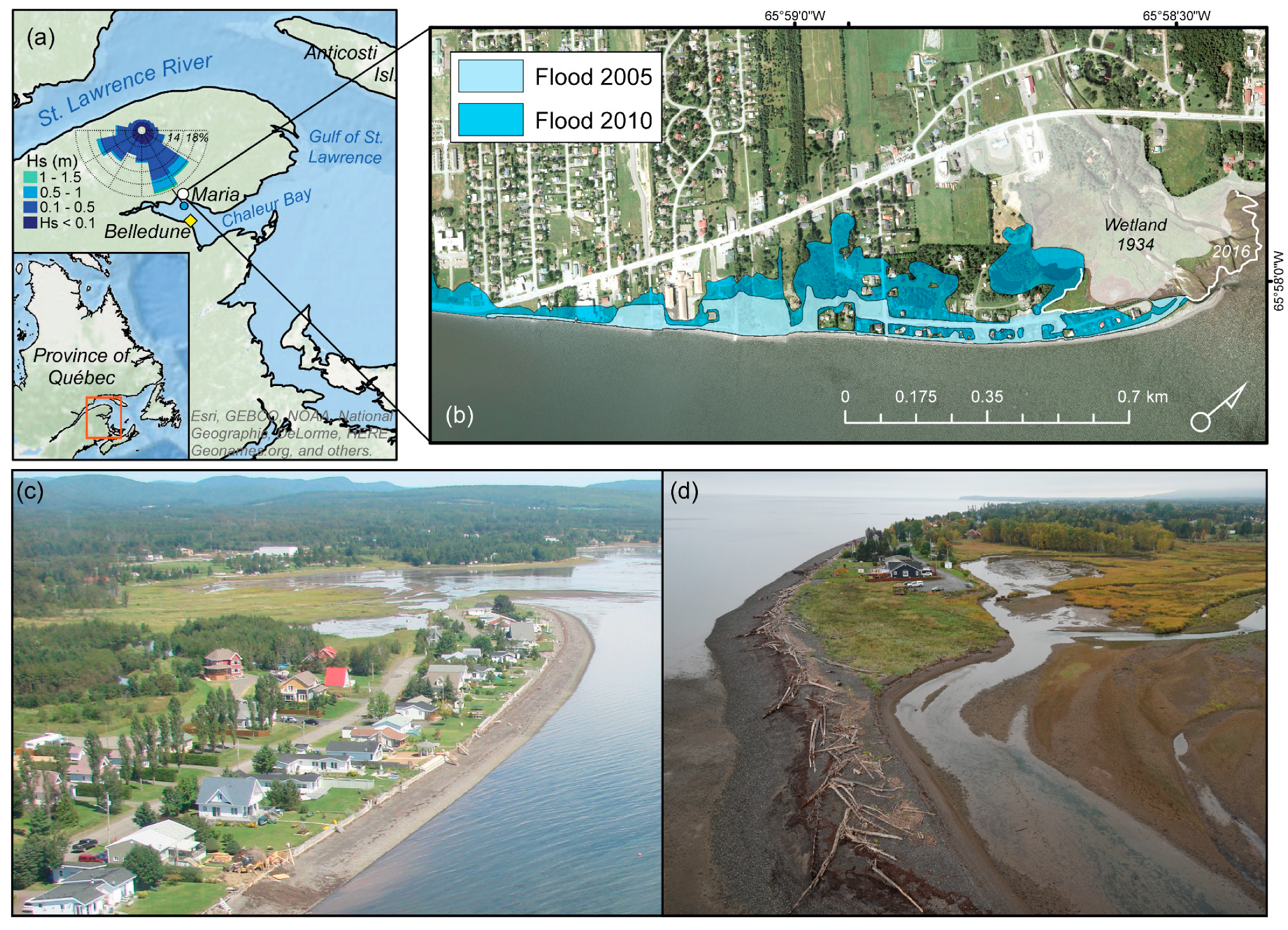
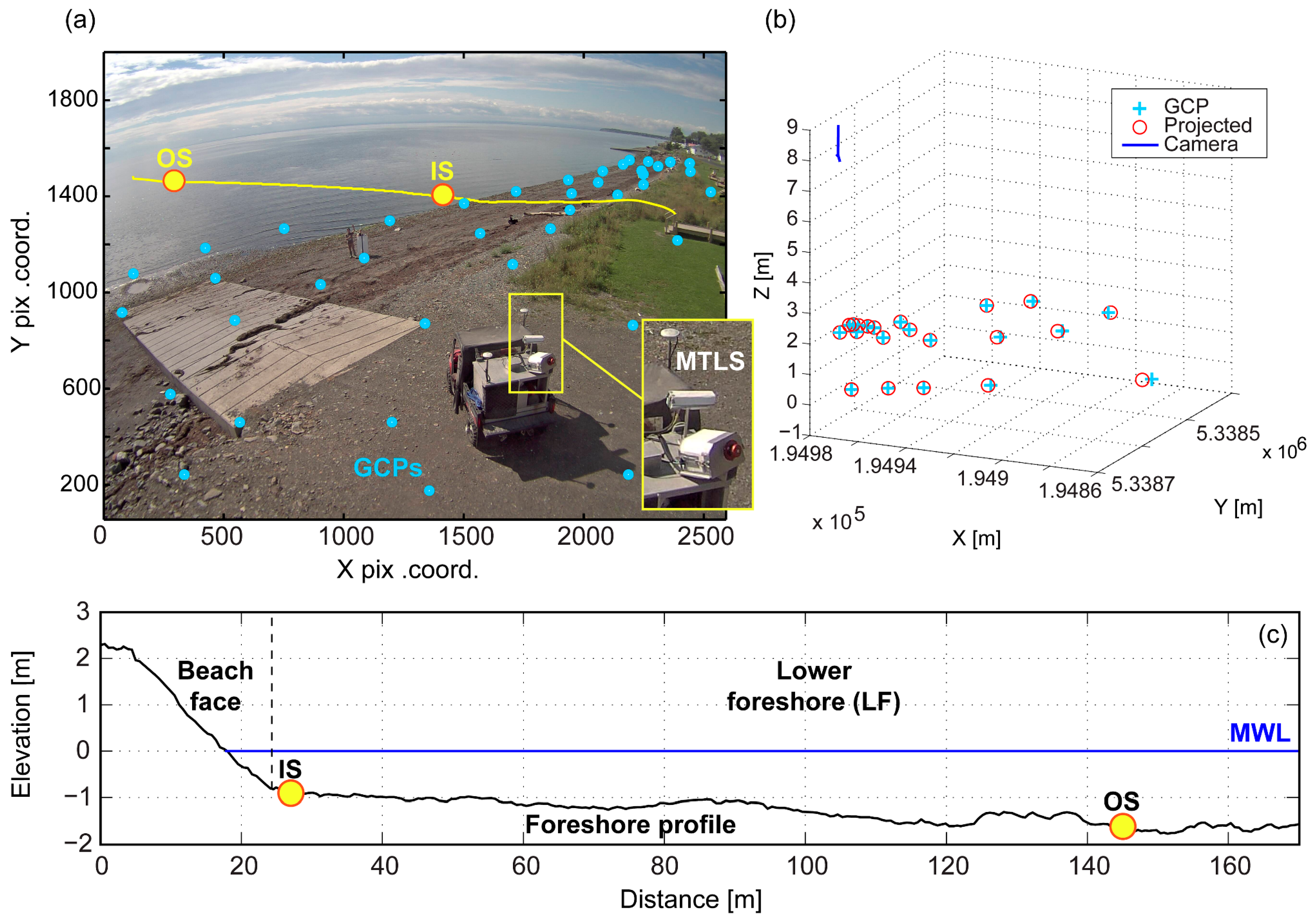
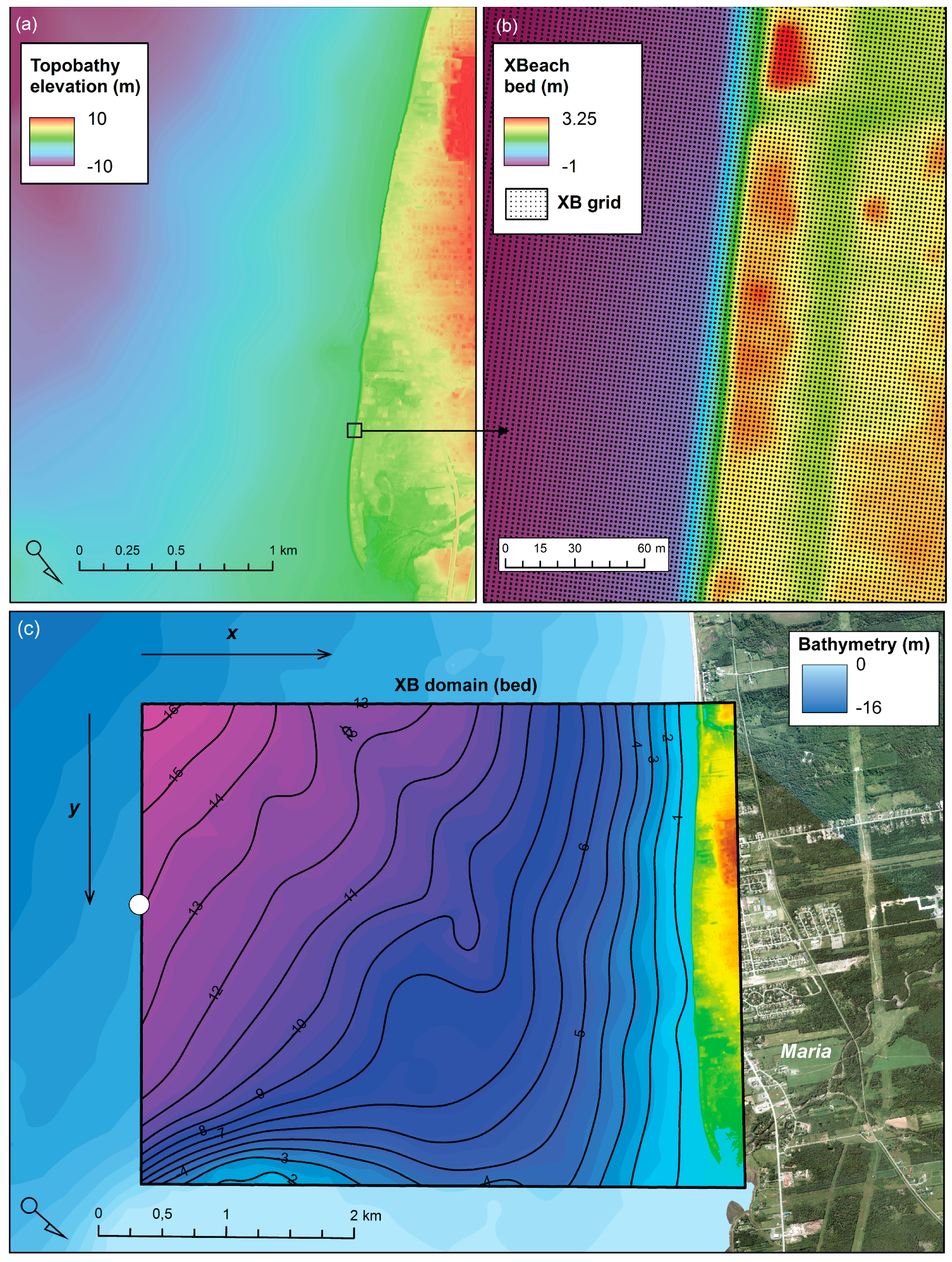

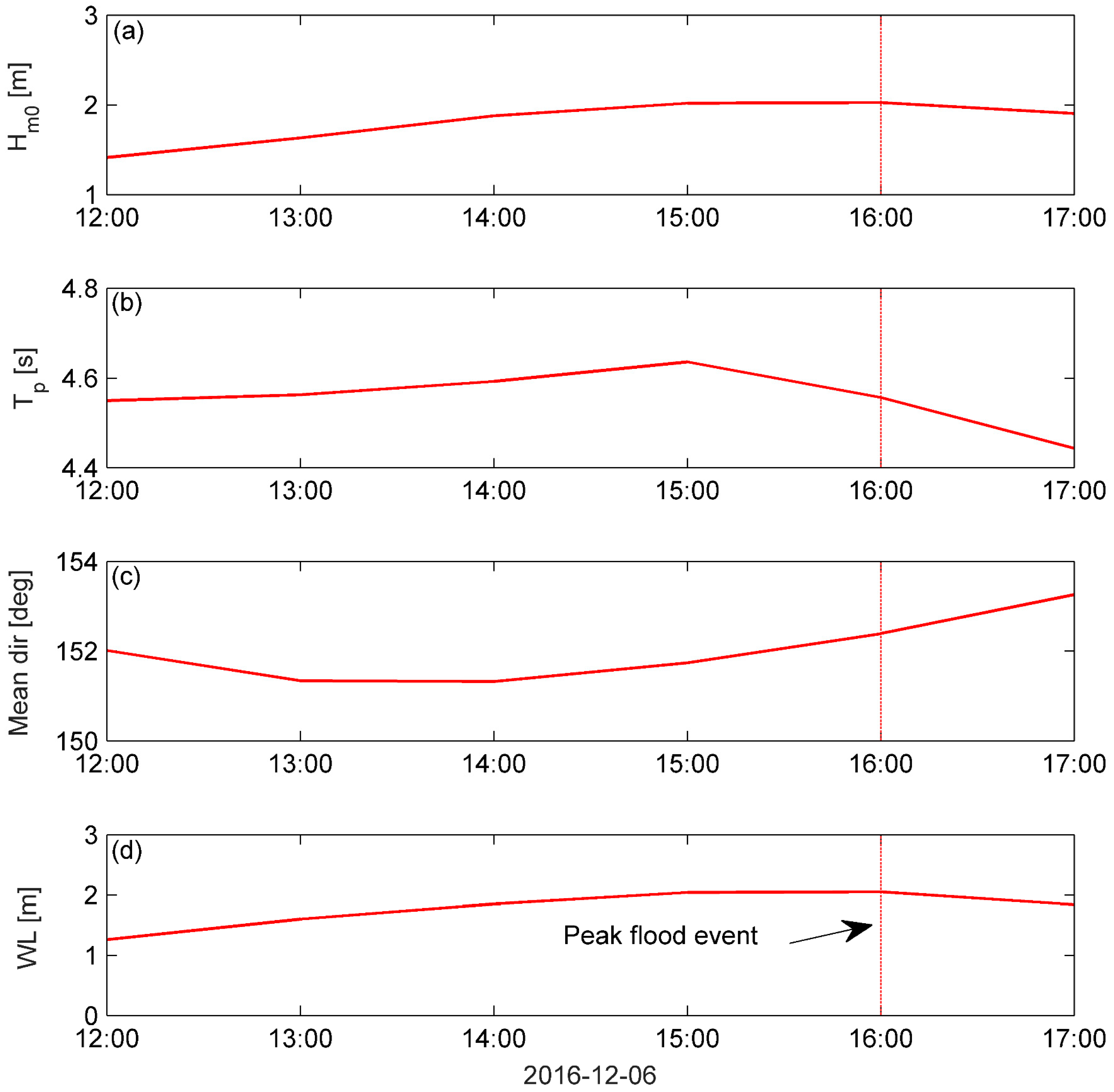
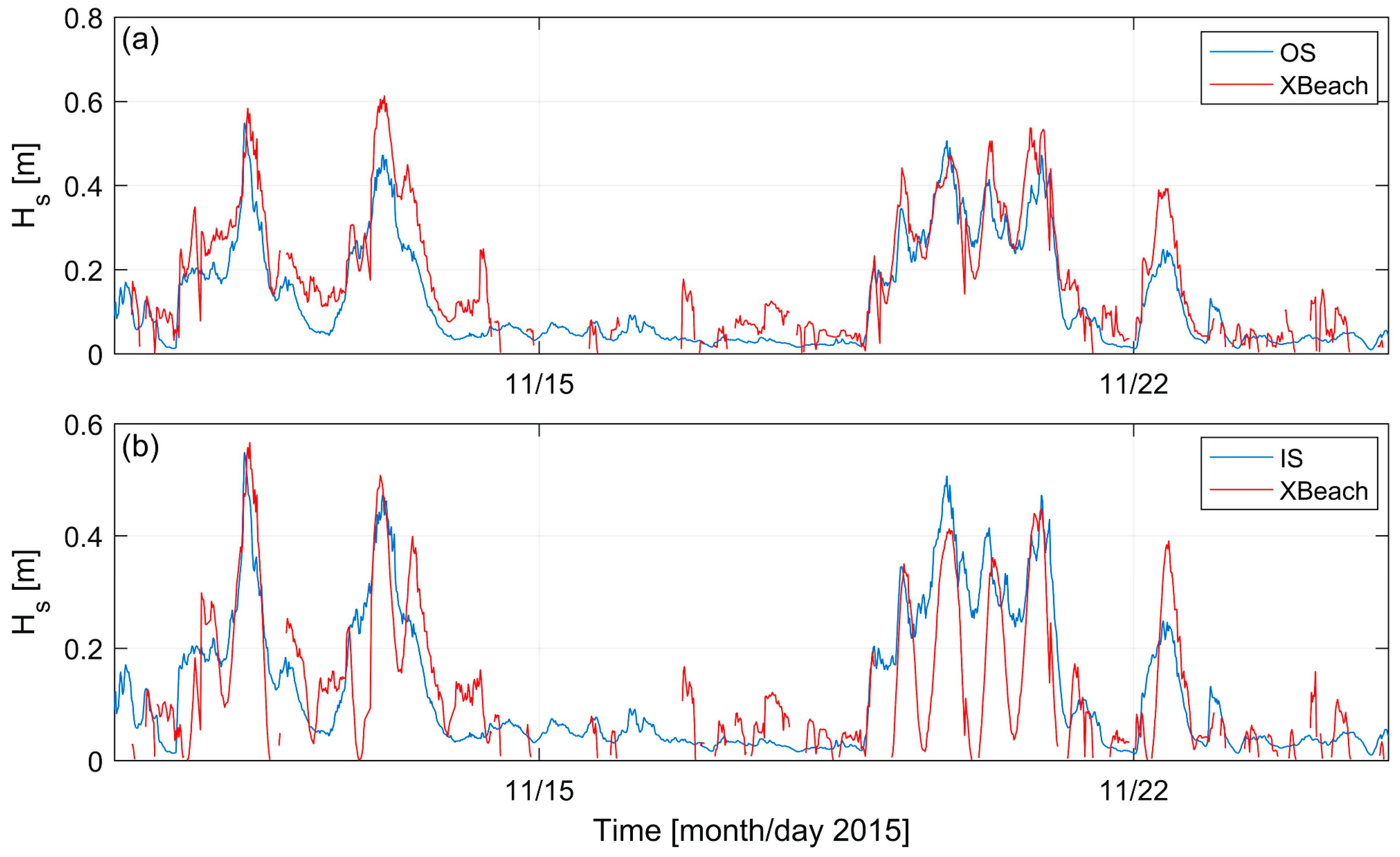

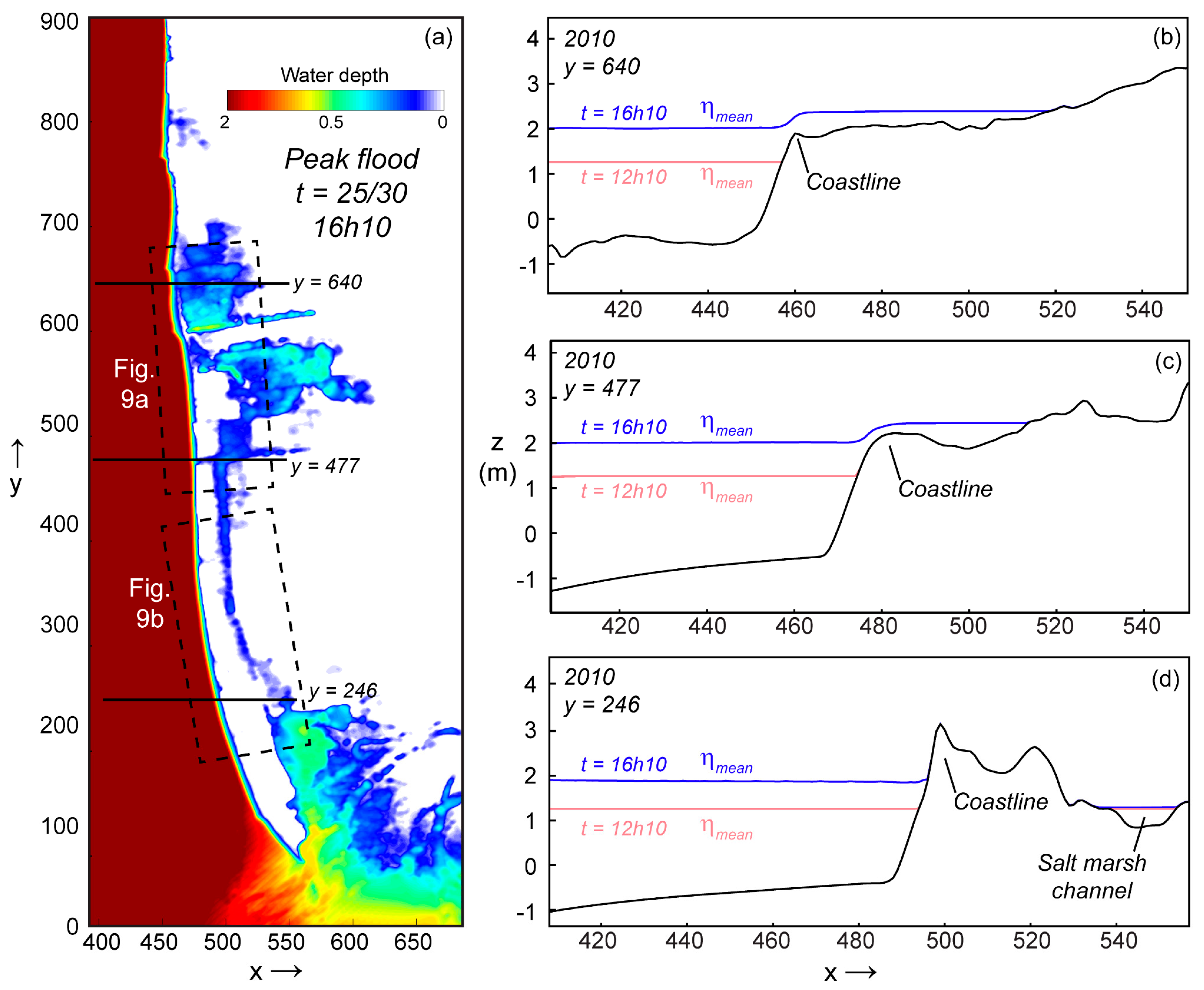
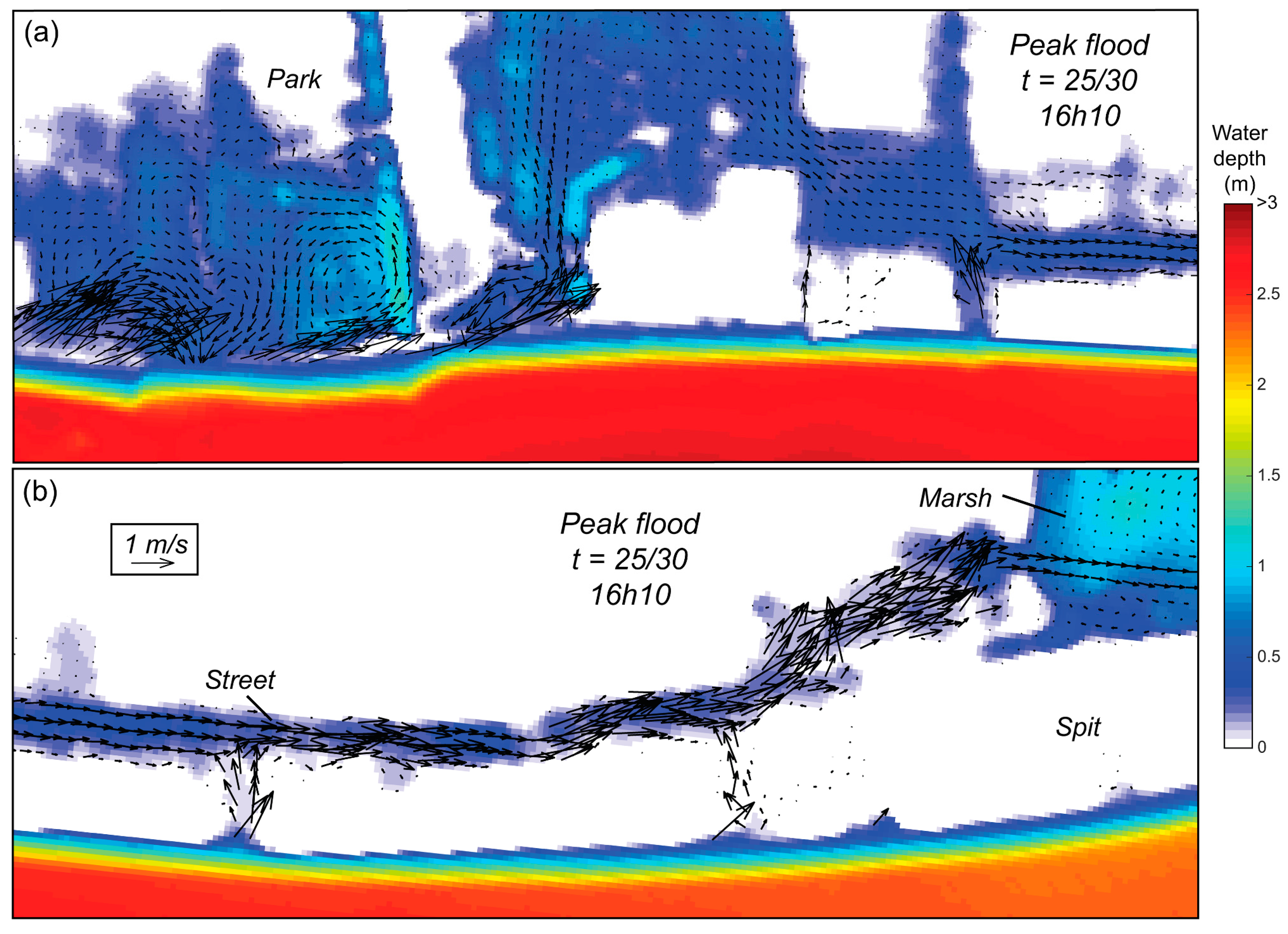
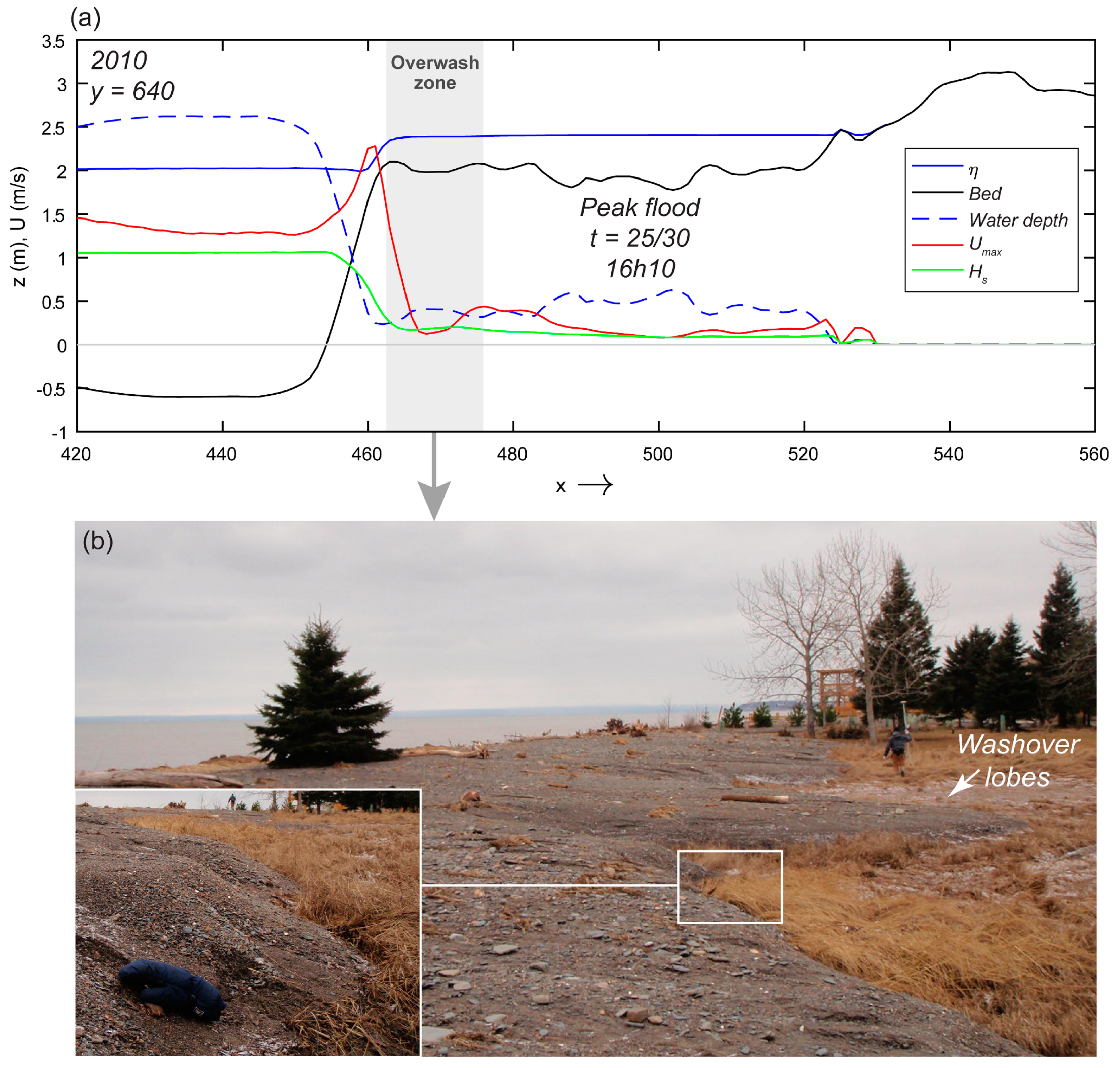
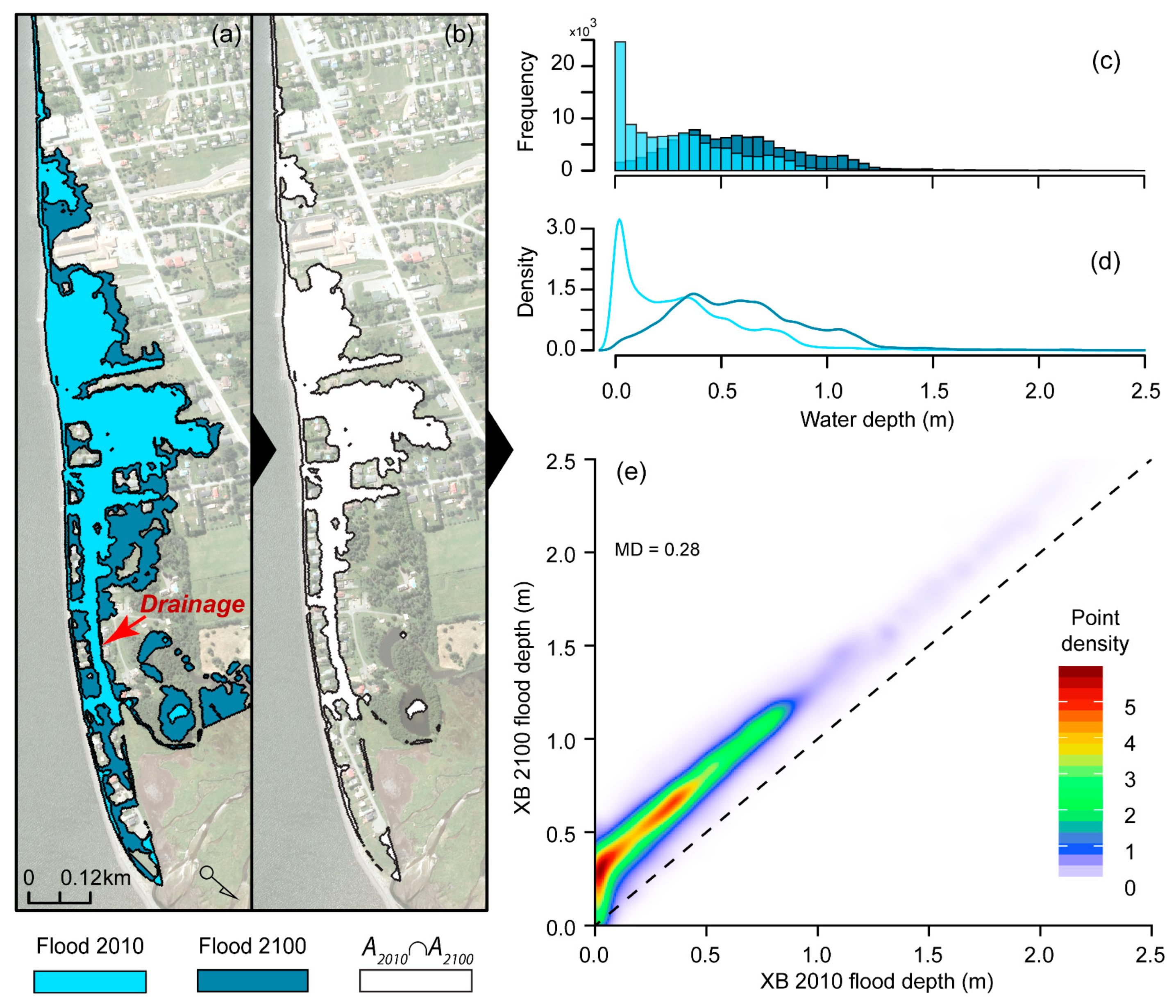
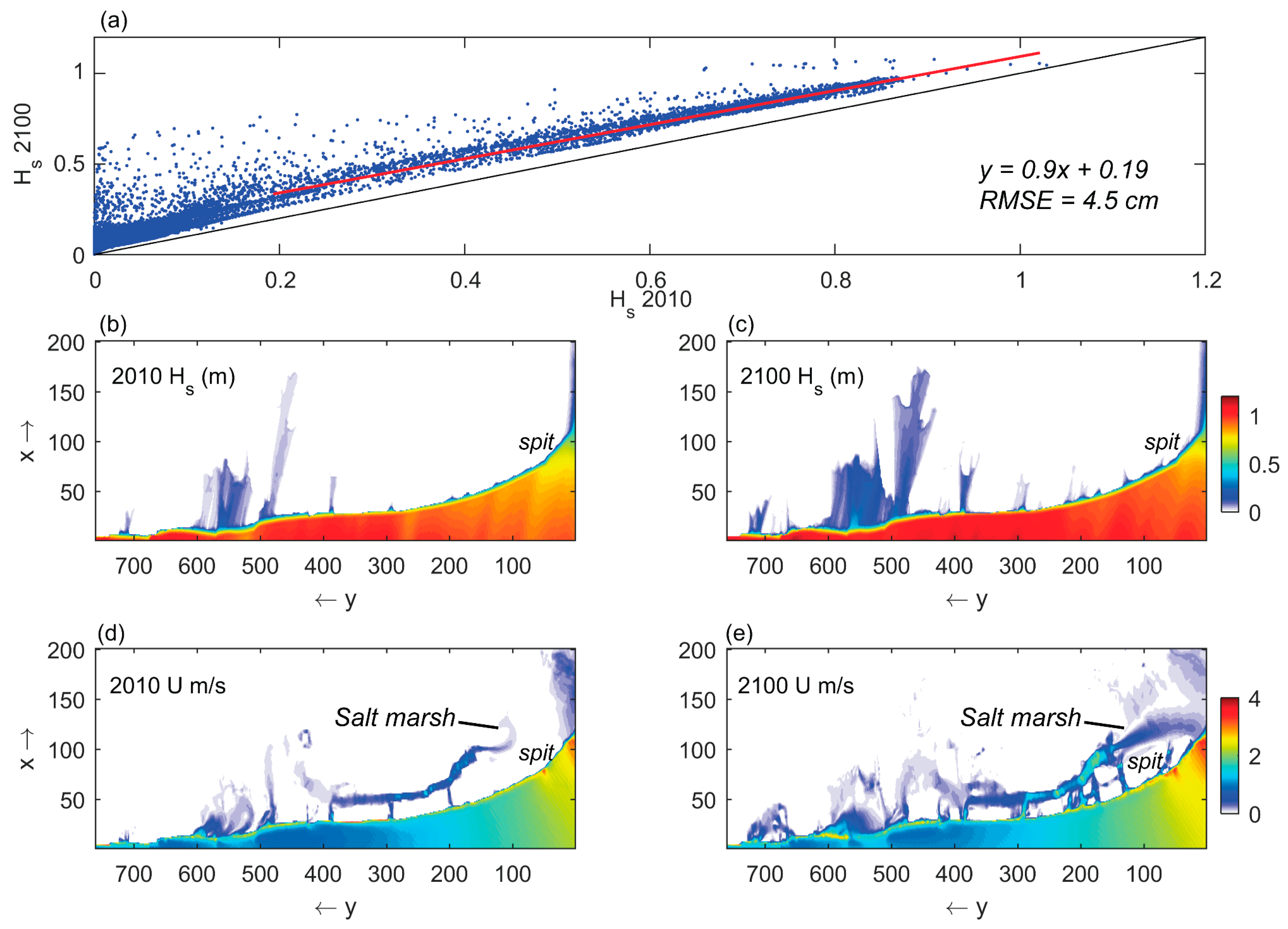

| Water Levels | Mean Value (2010) Chart Datum (CD) | Canadian Geodetic Vertical Datum 1928 (CGVD28) |
|---|---|---|
| Extreme level (tide + storm surge) | 3.64 | 2.46 |
| Highest Astronomical Tide (HAT) | 2.84 | 1.66 |
| Mean Sea Level (MSL) | 1.33 | 0.15 |
| Lowest Astronomical tide (LAT) | 0.1 | −1.08 |
| Variable | Sensor | RMSE | MAE | MBE | STD | a1 | a2 | r2 | Sample 1 |
|---|---|---|---|---|---|---|---|---|---|
| Hs | Inner LF | 0.05 | 0.05 | −0.01 | 0.06 | 0.85 | 0.01 | 0.80 | 386 |
| Outer LF | 0.05 | 0.06 | 0.03 | 0.07 | 0.81 | −0.01 | 0.85 | 502 |
© 2019 by the authors. Licensee MDPI, Basel, Switzerland. This article is an open access article distributed under the terms and conditions of the Creative Commons Attribution (CC BY) license (http://creativecommons.org/licenses/by/4.0/).
Share and Cite
Didier, D.; Bandet, M.; Bernatchez, P.; Dumont, D. Modelling Coastal Flood Propagation under Sea Level Rise: A Case Study in Maria, Eastern Canada. Geosciences 2019, 9, 76. https://doi.org/10.3390/geosciences9020076
Didier D, Bandet M, Bernatchez P, Dumont D. Modelling Coastal Flood Propagation under Sea Level Rise: A Case Study in Maria, Eastern Canada. Geosciences. 2019; 9(2):76. https://doi.org/10.3390/geosciences9020076
Chicago/Turabian StyleDidier, David, Marion Bandet, Pascal Bernatchez, and Dany Dumont. 2019. "Modelling Coastal Flood Propagation under Sea Level Rise: A Case Study in Maria, Eastern Canada" Geosciences 9, no. 2: 76. https://doi.org/10.3390/geosciences9020076
APA StyleDidier, D., Bandet, M., Bernatchez, P., & Dumont, D. (2019). Modelling Coastal Flood Propagation under Sea Level Rise: A Case Study in Maria, Eastern Canada. Geosciences, 9(2), 76. https://doi.org/10.3390/geosciences9020076






